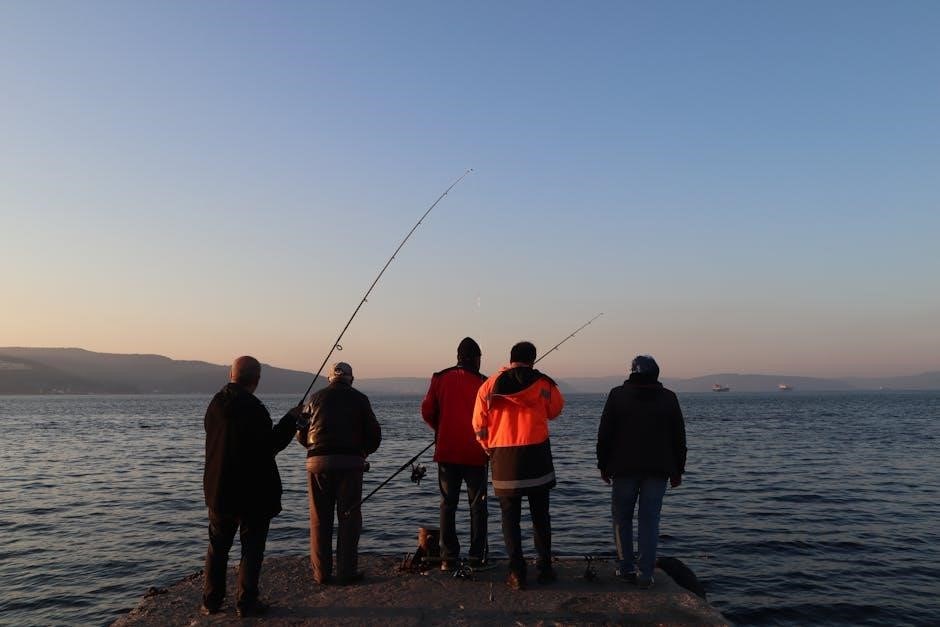Sturgeon fishing offers an exhilarating experience, targeting ancient fish species․ With expert sturgeon fishing guides, anglers can successfully navigate techniques, locations, and regulations, ensuring a safe and productive adventure․
1․1 What is Sturgeon Fishing?
Sturgeon fishing is a specialized form of angling targeting ancient sturgeon species․ These fish, often referred to as “living fossils,” have remained largely unchanged for millions of years․ Sturgeon fishing is considered a niche activity, appealing to experienced anglers and nature enthusiasts alike․ It involves techniques tailored to the unique behavior and habitats of sturgeon, which are known for their size, strength, and elusive nature․ The pursuit of sturgeon is challenging due to their deep-water habitats and specific feeding patterns, requiring specialized knowledge and equipment․ Many anglers are drawn to sturgeon fishing for its conservation significance, as these fish are often protected by regulations to ensure their survival․ The thrill of reeling in such an iconic creature, combined with the opportunity to contribute to conservation efforts, makes sturgeon fishing a rewarding and memorable experience․
1․2 The Importance of Sturgeon Fishing Guides
Sturgeon fishing guides are indispensable for a successful and enjoyable fishing experience․ Their extensive knowledge of sturgeon behavior, habitat, and feeding patterns ensures anglers target fish effectively․ Guides are well-versed in local regulations, helping to maintain sustainable fishing practices․ They provide expert advice on gear selection, techniques, and location scouting, maximizing the chances of a fruitful trip․ Additionally, guides often possess insights into prime fishing spots and optimal timing, enhancing the overall experience․ Their expertise not only improves the likelihood of catching sturgeon but also ensures a safe and environmentally responsible adventure․ Whether for beginners or experienced anglers, sturgeon fishing guides play a vital role in making the trip memorable and productive․

Understanding Sturgeon Biology
Understanding sturgeon biology is crucial for effective fishing․ These ancient fish have unique physical traits and life cycles, with insights into their behavior aiding conservation and fishing success․
2․1 Sturgeon Species Overview
There are over 20 sturgeon species worldwide, with varying sizes and characteristics․ The Beluga sturgeon is the largest, while the Lake Sturgeon is common in North American waters․ White Sturgeon and Siberian Sturgeon are also popular targets for anglers․ Each species has unique traits, such as differences in snout shape, scute patterns, and growth rates․ Understanding these variations is essential for effective fishing strategies․ Sturgeon are anadromous or freshwater species, adapting to diverse aquatic environments․ Their long lifespan and slow reproduction rate make conservation efforts critical․ Anglers and guides must recognize species-specific behaviors and habitats to ensure sustainable fishing practices; This knowledge enhances both the fishing experience and the protection of these ancient fish․
2․2 Sturgeon Habitat and Migration Patterns
Sturgeon are found in diverse aquatic environments, including rivers, estuaries, and coastal areas․ They prefer deep, slow-moving waters with soft substrates like sand or mud․ Some species migrate long distances between freshwater spawning grounds and saltwater feeding areas, while others remain in specific regions year-round․ Understanding their habitat preferences and migration routes is crucial for effective fishing strategies․ Guides often track seasonal movements to locate schooling sturgeon, ensuring anglers target active feeding areas․ Knowledge of their ecology helps preserve these ancient fish and enhances the overall fishing experience․ By studying habitat and migration patterns, anglers can better anticipate sturgeon behavior and increase their chances of a successful catch․
2․3 Sturgeon Behavior and Feeding Habits
Sturgeon are bottom-dwelling fish with unique behaviors adapted to their environment․ They are primarily nocturnal, spending most of their time near the river or lake bed․ These fish are opportunistic feeders, using their sensitive barbels to detect prey such as insects, crustaceans, and small fish․ They vacuum up food from the substrate, creating a distinctive “crunching” sound․ Sturgeon often congregate in areas with abundant nutrients, such as near dams or river bends․ Understanding their feeding patterns is essential for successful fishing, as they are most active during specific times of the day․ Guides can help anglers identify these feeding windows and choose the right bait or lures․ Knowledge of sturgeon behavior enhances the fishing experience and improves the likelihood of landing these remarkable creatures․

Sturgeon Fishing Techniques
Sturgeon fishing techniques vary, combining traditional and modern methods․ Expert guides teach effective strategies, ensuring a successful and safe fishing experience for anglers of all skill levels;
3․1 Traditional Sturgeon Fishing Methods
Traditional sturgeon fishing methods often involve simple yet effective techniques passed down through generations․ These include using handmade hooks, natural baits like fish roe or nightcrawlers, and bottom fishing strategies․ Anglers typically anchor in deep pools or near structure, waiting for sturgeon to feed․ Guides familiar with historical fishing grounds can significantly increase success rates․ These methods emphasize patience and a deep connection to the fish’s natural behavior․ While modern gear has evolved, traditional approaches remain popular for their authenticity and effectiveness․ Guides often blend these timeless techniques with contemporary insights, ensuring a balanced and rewarding experience for anglers seeking to connect with these ancient fish․
3․2 Modern Sturgeon Fishing Techniques
Modern sturgeon fishing techniques incorporate advanced gear and technology to enhance success․ Guides often recommend specialized rods, reels with high drag systems, and durable synthetic lines․ Electronic devices like fish finders and depth sounders help locate sturgeon efficiently․ Lures and baits are now designed with modern materials for better durability and appeal․ Techniques such as drifting, trolling, and jigging have gained popularity, offering anglers diverse strategies to target sturgeon․ These methods often require precision and adaptability, which experienced guides can expertly implement․ By combining traditional knowledge with contemporary tools, modern sturgeon fishing provides anglers with dynamic and effective ways to catch these elusive fish while ensuring sustainable practices․
3․3 Essential Gear and Tackle for Sturgeon Fishing
Sturgeon fishing requires durable and specialized gear to handle these powerful fish․ A medium to heavy action rod paired with a sturdy reel is essential, as sturgeon can exert immense strength․ Braided or monofilament lines with a minimum of 30-50 lb test are recommended for their strength and resistance to abrasion․ Large hooks, typically size 2 to 5/0, are ideal for sturgeon, and bait such as nightcrawlers, roe, or squid is often used․ Sinkers, including pyramid and egg sinkers, help reach bottom-dwelling sturgeon․ A landing net and pliers or a hook remover are crucial for safe handling and release․ Guides often emphasize the importance of high-quality tackle to ensure a successful and enjoyable fishing experience․
Sturgeon Fishing Regulations
Sturgeon fishing is heavily regulated to protect these ancient species․ Guides ensure anglers comply with permits, catch limits, and gear restrictions, promoting sustainable fishing practices and conservation efforts․
4․1 Why Sturgeon Fishing is Regulated
Sturgeon fishing is regulated due to the vulnerability of these ancient species․ Overfishing, habitat loss, and illegal trade have drastically reduced sturgeon populations, prompting strict conservation measures․ Regulations aim to protect sturgeon from further decline by limiting catches, enforcing size restrictions, and safeguarding spawning grounds․ Additionally, sturgeon are slow-growing and late-maturing, making them highly susceptible to overexploitation․ Without regulations, their populations could collapse, threatening biodiversity and ecosystems․ Regulatory frameworks also help monitor fishing practices, ensuring sustainability and the long-term survival of sturgeon․ By adhering to these rules, anglers and guides play a crucial role in preserving these magnificent creatures for future generations․
4․2 Key Regulations to Know Before Fishing
Understanding local regulations is crucial for a legal and ethical sturgeon fishing experience․ Licensing requirements often include specific permits for sturgeon, and catch limits vary by region․ Many areas enforce gear restrictions, such as hook type and bait usage, to reduce bycatch and protect juvenile fish․ Seasonal closures and protected spawning areas are common to ensure population sustainability․ Handling guidelines, like avoiding gill nets and minimizing handling time, are also enforced․ Additionally, some regions require catch-and-release fishing for certain species or size classes․ Always check local fish and wildlife agency rules before your trip․ Ignorance of regulations can lead to fines or penalties, so consulting with experienced sturgeon fishing guides or local authorities is highly recommended to ensure compliance․

Choosing the Right Sturgeon Fishing Guide
Selecting a knowledgeable guide is crucial for a successful sturgeon fishing trip․ Look for experienced professionals with in-depth local knowledge and a proven track record of success․
5․1 What to Look for in a Sturgeon Fishing Guide
When selecting a sturgeon fishing guide, prioritize experience and local knowledge․ Ensure they have years of guiding under their belt and understand the specific waters you’ll be fishing․ A reputable guide should have a proven track record of successful trips and satisfied clients․ Verify their knowledge of local regulations, as sturgeon fishing often involves strict rules to protect these ancient species․ Additionally, assess their equipment and gear quality to ensure safety and effectiveness․ Clear communication and a patient demeanor are essential for a positive experience, especially for novice anglers․ Lastly, choose a guide who emphasizes conservation and sustainable fishing practices to help preserve sturgeon populations for future generations․
5․2 Questions to Ask Your Guide
Before booking, ask your sturgeon fishing guide about their experience and success rates․ Inquire about the specific species and locations they specialize in, as well as the techniques they use․ Clarify what gear and equipment will be provided and what you need to bring․ Discuss the expected duration of the trip and the best times for fishing․ Ask about their knowledge of local regulations to ensure compliance․ Also, inquire about their safety protocols and emergency procedures․ Understanding their approach to catch-and-release practices is crucial for conservation-minded anglers․ Finally, ask for references or testimonials from past clients to gauge their reputation and reliability․ These questions will help ensure a well-prepared and enjoyable fishing experience tailored to your needs and expectations․

Planning Your Sturgeon Fishing Trip
Planning a sturgeon fishing trip requires careful consideration of timing, location, and preparation to maximize success and enjoyment․ Expert guides can help tailor your adventure․
6․1 Best Times of Year for Sturgeon Fishing
The best time for sturgeon fishing varies by region and species, but spring and fall are often prime seasons due to spawning migrations․ In cooler months, sturgeon tend to move to deeper waters, while warmer periods bring them to shallower areas․ Guides recommend targeting sturgeon during early morning or late evening when they are most active․ Weather conditions, such as overcast skies, can also enhance fishing success․ Understanding seasonal patterns is crucial for a productive trip, and experienced guides can help anglers choose the optimal time based on local conditions and fish behavior․ Proper timing increases the chances of encountering these elusive creatures and makes the adventure more rewarding․
6․2 Top Locations for Sturgeon Fishing
North America is renowned for its exceptional sturgeon fishing opportunities, with the Columbia River, Fraser River, and Mississippi River being prime destinations․ The Caspian Sea, home to the beluga sturgeon, is another hotspot․ In Europe, the Danube River and its tributaries offer fertile grounds for sturgeon․ Asia’s Yangtze River also boasts a healthy population of these ancient fish․ Each location provides unique habitats, from deep pools to shallow riffles, attracting sturgeon․ Guides often recommend specific spots based on seasonal migrations and spawning patterns․ These regions are not only rich in sturgeon populations but also offer breathtaking scenery, making the experience unforgettable․ Local knowledge is key to identifying the best fishing spots, ensuring anglers maximize their chances of catching these incredible creatures in their natural habitats․
6․3 Preparing for Your Fishing Adventure
Preparing for your sturgeon fishing adventure involves thorough planning to ensure success․ Start by checking and organizing your gear, including rods, reels, and bait․ Familiarize yourself with local regulations to avoid penalties; Physical conditioning is key, as sturgeon can be powerful fighters․ Mentally prepare for patience, as waits between bites can be long․ Research weather conditions and river levels, as these impact fish behavior․ Packing essentials like food, water, and first aid kits is crucial․ Lastly, consult your guide for tailored advice, ensuring you’re well-equipped and informed for a memorable experience․

On the Water: Tips for Success
Stay patient and alert, as sturgeon can strike unexpectedly․ Follow your guide’s instructions closely to maximize chances of success․ Keep gear organized and ready for action․
7․1 Setting Up for Sturgeon Fishing
Setting up for sturgeon fishing requires careful preparation to ensure success․ Start by selecting the right gear, including sturdy rods, reels, and lines capable of handling large fish․ Guides often recommend using bait such as nightcrawlers, fish roe, or stink baits, which sturgeon find irresistible․ Choose a location with strong currents or deep pools, as sturgeon tend to congregate in these areas․ Anchoring your boat in a strategic position is crucial, allowing your bait to sit naturally on the riverbed․ Always follow local regulations regarding gear and bait usage․ A well-organized setup increases your chances of attracting and landing these magnificent creatures․ Pay attention to your guide’s instructions for optimal placement and presentation․
7․2 Casting and Waiting for a Bite
Casting for sturgeon requires precision and patience․ Guides often recommend using a strong, steady motion to cover target areas effectively․ Once your line is cast, the waiting game begins․ Sturgeon can be sluggish to bite, so staying alert and focused is crucial․ Guides will typically advise on the best baits and presentations to attract these fish․ While waiting, it’s important to keep your line taut and your senses sharp, as sturgeon bites can be subtle but powerful․ Experienced guides will help you interpret nibbles and determine when to set the hook․ This phase demands patience and trust in your guide’s expertise, as sturgeon are known for their unpredictable behavior; By following their instructions, you’ll maximize your chances of landing these incredible creatures․
7․3 Landing and Handling Sturgeon
Landing sturgeon requires patience and care․ Use a sturdy net to avoid injuring the fish or losing gear․ Guides emphasize gentle handling to preserve the sturgeon’s strength for release․
When handling, support the fish firmly but carefully, avoiding gill contact․ Keep the sturgeon in the water as much as possible to reduce stress․
For photos, ensure quick poses and minimal handling time․ Guides often assist in safely releasing sturgeon, promoting conservation and ensuring the fish thrive for future anglers․








